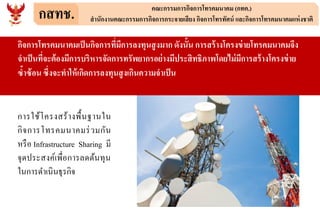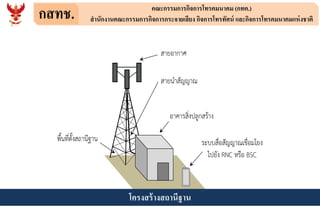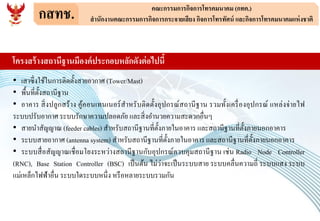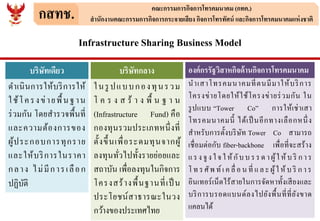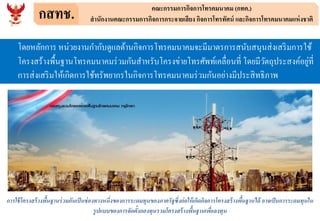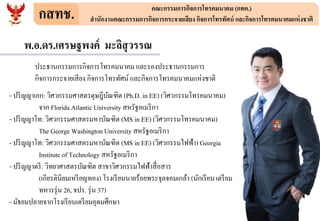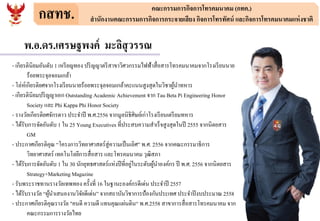ŗłě.ŗł≠.ŗłĒŗł£.ŗĻÄŗł®ŗł£ŗł©ŗłźŗłěŗłáŗłĄŗĻĆ Infrastructure sharing
- 1. ŗłĀŗł™ŗłóŗłä. ŗłĄŗłďŗłįŗłĀŗł£ŗł£ŗł°ŗłĀŗł≤ŗł£ŗłĀŗłīŗłąŗłĀŗł≤ŗł£ŗĻāŗłóŗł£ŗłĄŗł°ŗłôŗł≤ŗłĄŗł° (ŗłĀŗłóŗłĄ.) ŗł™ŗł≤ŗłôŗłĪŗłĀŗłáŗł≤ŗłôŗłĄŗłďŗłįŗłĀŗł£ŗł£ŗł°ŗłĀŗł≤ŗł£ŗłĀŗłīŗłąŗłĀŗł≤ŗł£ŗłĀŗł£ŗłįŗłąŗł≤ŗłĘŗĻÄŗł™ŗłĶŗłĘŗłá ŗłĀŗłīŗłąŗłĀŗł≤ŗł£ŗĻāŗłóŗł£ŗłóŗłĪŗł®ŗłôŗĻĆ ŗĻĀŗł•ŗłįŗłĀŗłīŗłąŗłĀŗł≤ŗł£ŗĻāŗłóŗł£ŗłĄŗł°ŗłôŗł≤ŗłĄŗł°ŗĻĀŗłęŗĻąŗłáŗłäŗł≤ŗłēŗłī Infrastructure Sharing in Telecommunications : Fundamental and Analysis ŗłě.ŗł≠.ŗłĒŗł£.ŗĻÄŗł®ŗł£ŗł©ŗłźŗłěŗłáŗłĄŗĻĆ ŗł°ŗłįŗł•ŗłīŗł™ŗłłŗłßŗł£ŗł£ŗłď ŗłõŗł£ŗłįŗłėŗł≤ŗłôŗłĀŗł£ŗł£ŗł°ŗłĀŗł≤ŗł£ŗłĀŗłīŗłąŗłĀŗł≤ŗł£ŗĻāŗłóŗł£ŗłĄŗł°ŗłôŗł≤ŗłĄŗł° ŗĻĀŗł•ŗłįŗł£ŗł≠ŗłáŗłõŗł£ŗłįŗłėŗł≤ŗłô ŗłĀŗł™ŗłóŗłä.
- 2. ŗłĀŗł™ŗłóŗłä. ŗłĄŗłďŗłįŗłĀŗł£ŗł£ŗł°ŗłĀŗł≤ŗł£ŗłĀŗłīŗłąŗłĀŗł≤ŗł£ŗĻāŗłóŗł£ŗłĄŗł°ŗłôŗł≤ŗłĄŗł° (ŗłĀŗłóŗłĄ.) ŗł™ŗł≤ŗłôŗłĪŗłĀŗłáŗł≤ŗłôŗłĄŗłďŗłįŗłĀŗł£ŗł£ŗł°ŗłĀŗł≤ŗł£ŗłĀŗłīŗłąŗłĀŗł≤ŗł£ŗłĀŗł£ŗłįŗłąŗł≤ŗłĘŗĻÄŗł™ŗłĶŗłĘŗłá ŗłĀŗłīŗłąŗłĀŗł≤ŗł£ŗĻāŗłóŗł£ŗłóŗłĪŗł®ŗłôŗĻĆ ŗĻĀŗł•ŗłįŗłĀŗłīŗłąŗłĀŗł≤ŗł£ŗĻāŗłóŗł£ŗłĄŗł°ŗłôŗł≤ŗłĄŗł°ŗĻĀŗłęŗĻąŗłáŗłäŗł≤ŗłēŗłī ŗłĀŗłīŗłąŗłĀŗł≤ŗł£ŗĻāŗłóŗł£ŗłĄŗł°ŗłôŗł≤ŗłĄŗł°ŗĻÄŗłõŗĻáŗłôŗłĀŗłīŗłąŗłĀŗł≤ŗł£ŗłóŗłĶŗĻąŗł°ŗłĶŗłĀŗł≤ŗł£ŗł•ŗłáŗłóŗłłŗłôŗł™ŗłĻŗłáŗł°ŗł≤ŗłĀ ŗłĒŗłĪŗłáŗłôŗłĪŗĻČŗłô ŗłĀŗł≤ŗł£ŗł™ŗł£ŗĻČŗł≤ŗłáŗĻāŗłĄŗł£ŗłáŗłāŗĻąŗł≤ŗłĘŗĻāŗłóŗł£ŗłĄŗł°ŗłôŗł≤ŗłĄŗł°ŗłąŗł∂ŗłá ŗłąŗł≤ŗĻÄŗłõŗĻáŗłôŗłóŗłĶŗĻąŗłąŗłįŗłēŗĻČŗł≠ŗłáŗł°ŗłĶŗłĀŗł≤ŗł£ŗłöŗł£ŗłīŗłęŗł≤ŗł£ŗłąŗłĪŗłĒŗłĀŗł≤ŗł£ŗłóŗł£ŗłĪŗłěŗłĘŗł≤ŗłĀŗł£ŗł≠ŗłĘŗĻąŗł≤ŗłáŗł°ŗłĶŗłõŗł£ŗłįŗł™ŗłīŗłóŗłėŗłīŗł†ŗł≤ŗłěŗĻāŗłĒŗłĘŗĻĄŗł°ŗĻąŗł°ŗłĶŗłĀŗł≤ŗł£ŗł™ŗł£ŗĻČŗł≤ŗłáŗĻāŗłĄŗł£ŗłáŗłāŗĻąŗł≤ŗłĘ ŗłčŗĻČŗł≤ŗłčŗĻČŗł≠ŗłô ŗłčŗł∂ŗĻąŗłáŗłąŗłįŗłóŗł≤ŗĻÉŗłęŗĻČŗĻÄŗłĀŗłīŗłĒŗłĀŗł≤ŗł£ŗł•ŗłáŗłóŗłłŗłôŗł™ŗłĻŗłáŗĻÄŗłĀŗłīŗłôŗłĄŗłßŗł≤ŗł°ŗłąŗł≤ŗĻÄŗłõŗĻáŗłô ŗłĀŗł≤ŗł£ŗĻÉŗłäŗĻČŗĻāŗłĄŗł£ŗłáŗł™ŗł£ŗĻČŗł≤ŗłáŗłěŗł∑ŗĻČŗłôŗłźŗł≤ŗłôŗĻÉŗłô ŗłĀŗłīŗłąŗłĀŗł≤ŗł£ŗĻāŗłóŗł£ŗłĄŗł°ŗłôŗł≤ŗłĄŗł°ŗł£ŗĻąŗłßŗł°ŗłĀŗłĪŗłô ŗłęŗł£ŗł∑ŗł≠ Infrastructure Sharing ŗł°ŗłĶ ŗłąŗłłŗłĒŗłõŗł£ŗłįŗł™ŗłáŗłĄŗĻĆŗĻÄŗłěŗł∑ŗĻąŗł≠ŗłĀŗł≤ŗł£ŗł•ŗłĒŗłēŗĻČŗłôŗłóŗłłŗłô ŗĻÉŗłôŗłĀŗł≤ŗł£ŗłĒŗł≤ŗĻÄŗłôŗłīŗłôŗłėŗłłŗł£ŗłĀŗłīŗłą
- 3. ŗłĀŗł™ŗłóŗłä. ŗłĄŗłďŗłįŗłĀŗł£ŗł£ŗł°ŗłĀŗł≤ŗł£ŗłĀŗłīŗłąŗłĀŗł≤ŗł£ŗĻāŗłóŗł£ŗłĄŗł°ŗłôŗł≤ŗłĄŗł° (ŗłĀŗłóŗłĄ.) ŗł™ŗł≤ŗłôŗłĪŗłĀŗłáŗł≤ŗłôŗłĄŗłďŗłįŗłĀŗł£ŗł£ŗł°ŗłĀŗł≤ŗł£ŗłĀŗłīŗłąŗłĀŗł≤ŗł£ŗłĀŗł£ŗłįŗłąŗł≤ŗłĘŗĻÄŗł™ŗłĶŗłĘŗłá ŗłĀŗłīŗłąŗłĀŗł≤ŗł£ŗĻāŗłóŗł£ŗłóŗłĪŗł®ŗłôŗĻĆ ŗĻĀŗł•ŗłįŗłĀŗłīŗłąŗłĀŗł≤ŗł£ŗĻāŗłóŗł£ŗłĄŗł°ŗłôŗł≤ŗłĄŗł°ŗĻĀŗłęŗĻąŗłáŗłäŗł≤ŗłēŗłī ŗłĀŗł≤ŗł£ŗĻÉŗłäŗĻČŗĻāŗłĄŗł£ŗłáŗł™ŗł£ŗĻČŗł≤ŗłáŗłěŗł∑ŗĻČŗłôŗłźŗł≤ŗłôŗł£ŗĻąŗłßŗł°ŗłĀŗłĪŗłô ŗĻÄŗłõŗĻáŗłôŗłĀŗł≤ŗł£ ŗł•ŗłĒŗłěŗł∑ŗĻČŗłôŗłóŗłĶŗĻąŗĻÉŗłôŗłĀŗł≤ŗł£ŗĻĄŗłõŗłēŗłĪŗĻČŗłáŗĻÄŗł™ŗł≤ŗĻāŗłóŗł£ŗłĄŗł°ŗłôŗł≤ŗłĄŗł°ŗłčŗł∂ŗĻąŗłá ŗĻÄŗłõŗĻáŗłôŗłĀŗł≤ŗł£ŗĻÉŗłäŗĻČŗłěŗł∑ŗĻČŗłôŗłóŗłĶŗĻąŗł£ŗĻąŗłßŗł°ŗłĀŗłĪŗłôŗłóŗł≤ŗĻÉŗłęŗĻČŗłĀŗł≤ŗł£ŗĻÉŗłäŗĻČŗłěŗł∑ŗĻČŗłôŗłóŗłĶŗĻą ŗĻÄŗłõŗĻáŗłôŗĻĄŗłõŗł≠ŗłĘŗĻąŗł≤ŗłáŗł°ŗłĶŗłõŗł£ŗłįŗł™ŗłīŗłóŗłėŗłīŗł†ŗł≤ŗłě ŗĻĄŗł°ŗĻąŗłöŗłĒŗłöŗłĪŗłá ŗłóŗłĪŗł®ŗłôŗłĶŗłĘŗł†ŗł≤ŗłěŗłēŗĻąŗł≤ŗłáŗĻÜ ŗĻĀŗł•ŗłįŗłĘŗłĪŗłáŗĻÄŗłõŗĻáŗłôŗłĀŗł≤ŗł£ŗł•ŗłĒŗłĄŗĻąŗł≤ŗĻÉŗłäŗĻČŗłąŗĻąŗł≤ŗłĘŗłóŗłĶŗĻąŗłčŗĻČŗł≤ŗłčŗĻČŗł≠ŗłô ŗłčŗł∂ŗĻąŗłáŗĻÄŗłõŗĻáŗłô ŗłĀŗł≤ŗł£ŗł•ŗłĒŗłēŗĻČŗłôŗłóŗłłŗłôŗłāŗł≠ŗłáŗłúŗłĻŗĻČŗłõŗł£ŗłįŗłĀŗł≠ŗłöŗłĀŗł≤ŗł£ŗĻĄŗłõŗłĒŗĻČŗłßŗłĘ
- 4. ŗłĀŗł™ŗłóŗłä. ŗłĄŗłďŗłįŗłĀŗł£ŗł£ŗł°ŗłĀŗł≤ŗł£ŗłĀŗłīŗłąŗłĀŗł≤ŗł£ŗĻāŗłóŗł£ŗłĄŗł°ŗłôŗł≤ŗłĄŗł° (ŗłĀŗłóŗłĄ.) ŗł™ŗł≤ŗłôŗłĪŗłĀŗłáŗł≤ŗłôŗłĄŗłďŗłįŗłĀŗł£ŗł£ŗł°ŗłĀŗł≤ŗł£ŗłĀŗłīŗłąŗłĀŗł≤ŗł£ŗłĀŗł£ŗłįŗłąŗł≤ŗłĘŗĻÄŗł™ŗłĶŗłĘŗłá ŗłĀŗłīŗłąŗłĀŗł≤ŗł£ŗĻāŗłóŗł£ŗłóŗłĪŗł®ŗłôŗĻĆ ŗĻĀŗł•ŗłįŗłĀŗłīŗłąŗłĀŗł≤ŗł£ŗĻāŗłóŗł£ŗłĄŗł°ŗłôŗł≤ŗłĄŗł°ŗĻĀŗłęŗĻąŗłáŗłäŗł≤ŗłēŗłī RNC BSC ŗĻāŗłĄŗł£ŗłáŗł™ŗł£ŗĻČŗł≤ŗłáŗł™ŗłĖŗł≤ŗłôŗłĶŗłźŗł≤ŗłô
- 5. ŗłĀŗł™ŗłóŗłä. ŗłĄŗłďŗłįŗłĀŗł£ŗł£ŗł°ŗłĀŗł≤ŗł£ŗłĀŗłīŗłąŗłĀŗł≤ŗł£ŗĻāŗłóŗł£ŗłĄŗł°ŗłôŗł≤ŗłĄŗł° (ŗłĀŗłóŗłĄ.) ŗł™ŗł≤ŗłôŗłĪŗłĀŗłáŗł≤ŗłôŗłĄŗłďŗłįŗłĀŗł£ŗł£ŗł°ŗłĀŗł≤ŗł£ŗłĀŗłīŗłąŗłĀŗł≤ŗł£ŗłĀŗł£ŗłįŗłąŗł≤ŗłĘŗĻÄŗł™ŗłĶŗłĘŗłá ŗłĀŗłīŗłąŗłĀŗł≤ŗł£ŗĻāŗłóŗł£ŗłóŗłĪŗł®ŗłôŗĻĆ ŗĻĀŗł•ŗłįŗłĀŗłīŗłąŗłĀŗł≤ŗł£ŗĻāŗłóŗł£ŗłĄŗł°ŗłôŗł≤ŗłĄŗł°ŗĻĀŗłęŗĻąŗłáŗłäŗł≤ŗłēŗłī ‚ÄĘ ŗĻÄŗł™ŗł≤ŗłčŗł∂ŗĻąŗłáŗĻÉŗłäŗĻČŗĻÉŗłôŗłĀŗł≤ŗł£ŗłēŗłīŗłĒŗłēŗłĪŗĻČŗłáŗł™ŗł≤ŗłĘŗł≠ŗł≤ŗłĀŗł≤ŗł® (Tower/Mast) ‚ÄĘ ŗłěŗł∑ŗĻČŗłôŗłóŗłĶŗĻąŗłēŗłĪŗĻČŗłáŗł™ŗłĖŗł≤ŗłôŗłĶŗłźŗł≤ŗłô ‚ÄĘ ŗł≠ŗł≤ŗłĄŗł≤ŗł£ ŗł™ŗłīŗĻąŗłáŗłõŗł•ŗłĻŗłĀŗł™ŗł£ŗĻČŗł≤ŗłá ŗłĄŗłĻŗĻČŗłĄŗł≠ŗłôŗĻÄŗłóŗłôŗĻÄŗłôŗł≠ŗł£ŗĻĆŗł™ŗł≤ŗłęŗł£ŗłĪŗłöŗłēŗłīŗłĒŗłēŗłĪŗĻČŗłáŗł≠ŗłłŗłõŗłĀŗł£ŗłďŗĻĆŗł™ŗłĖŗł≤ŗłôŗłĶŗłźŗł≤ŗłô ŗł£ŗłßŗł°ŗłóŗłĪŗĻČŗłáŗĻÄŗłĄŗł£ŗł∑ŗĻąŗł≠ŗłáŗł≠ŗłłŗłõŗłĀŗł£ŗłďŗĻĆ ŗĻĀŗłęŗł•ŗĻąŗłáŗłąŗĻąŗł≤ŗłĘŗĻĄŗłü ŗł£ŗłįŗłöŗłöŗłõŗł£ŗłĪŗłöŗł≠ŗł≤ŗłĀŗł≤ŗł® ŗł£ŗłįŗłöŗłöŗł£ŗłĪŗłĀŗł©ŗł≤ŗłĄŗłßŗł≤ŗł°ŗłõŗł•ŗł≠ŗłĒŗł†ŗłĪŗłĘ ŗĻĀŗł•ŗłįŗł™ŗłīŗĻąŗłáŗł≠ŗł≤ŗłôŗłßŗłĘŗłĄŗłßŗł≤ŗł°ŗł™ŗłįŗłĒŗłßŗłĀŗł≠ŗł∑ŗĻąŗłôŗĻÜ ‚ÄĘ ŗł™ŗł≤ŗłĘŗłôŗł≤ŗł™ŗłĪŗłćŗłćŗł≤ŗłď (feeder cables) ŗł™ŗł≤ŗłęŗł£ŗłĪŗłöŗł™ŗłĖŗł≤ŗłôŗłĶŗłźŗł≤ŗłôŗłóŗłĶŗĻąŗłēŗłĪŗĻČŗłáŗł†ŗł≤ŗłĘŗĻÉŗłôŗł≠ŗł≤ŗłĄŗł≤ŗł£ ŗĻĀŗł•ŗłįŗł™ŗłĖŗł≤ŗłôŗłĶŗłźŗł≤ŗłôŗłóŗłĶŗĻąŗłēŗłĪŗĻČŗłáŗł†ŗł≤ŗłĘŗłôŗł≠ŗłĀŗł≠ŗł≤ŗłĄŗł≤ŗł£ ‚ÄĘ ŗł£ŗłįŗłöŗłöŗł™ŗł≤ŗłĘŗł≠ŗł≤ŗłĀŗł≤ŗł® (antenna system) ŗł™ŗł≤ŗłęŗł£ŗłĪŗłöŗł™ŗłĖŗł≤ŗłôŗłĶŗłźŗł≤ŗłôŗłóŗłĶŗĻąŗłēŗłĪŗĻČŗłáŗł†ŗł≤ŗłĘŗĻÉŗłôŗł≠ŗł≤ŗłĄŗł≤ŗł£ ŗĻĀŗł•ŗłįŗł™ŗłĖŗł≤ŗłôŗłĶŗłźŗł≤ŗłôŗłóŗłĶŗĻąŗłēŗłĪŗĻČŗłáŗł†ŗł≤ŗłĘŗłôŗł≠ŗłĀŗł≠ŗł≤ŗłĄŗł≤ŗł£ ‚ÄĘ ŗł£ŗłįŗłöŗłöŗł™ŗł∑ŗĻąŗł≠ŗł™ŗłĪŗłćŗłćŗł≤ŗłďŗĻÄŗłäŗł∑ŗĻąŗł≠ŗł°ŗĻāŗłĘŗłáŗł£ŗłįŗłęŗłßŗĻąŗł≤ŗłáŗł™ŗłĖŗł≤ŗłôŗłĶŗłźŗł≤ŗłôŗłĀŗłĪŗłöŗł≠ŗłłŗłõŗłĀŗł£ŗłďŗĻĆŗłĄŗłßŗłöŗłĄŗłłŗł°ŗł™ŗłĖŗł≤ŗłôŗłĶŗłźŗł≤ŗłô ŗĻÄŗłäŗĻąŗłô Radio Node Controller (RNC), Base Station Controller (BSC) ŗĻÄŗłõŗĻáŗłôŗłēŗĻČŗłô ŗĻĄŗł°ŗĻąŗłßŗĻąŗł≤ŗłąŗłįŗĻÄŗłõŗĻáŗłôŗł£ŗłįŗłöŗłöŗł™ŗł≤ŗłĘ ŗł£ŗłįŗłöŗłöŗłĄŗł•ŗł∑ŗĻąŗłôŗłĄŗłßŗł≤ŗł°ŗłĖŗłĶŗĻą ŗł£ŗłįŗłöŗłöŗĻĀŗł™ŗłá ŗł£ŗłįŗłöŗłö ŗĻĀŗł°ŗĻąŗĻÄŗłęŗł•ŗĻáŗłĀŗĻĄŗłüŗłüŗĻČŗł≤ŗł≠ŗł∑ŗĻąŗłô ŗł£ŗłįŗłöŗłöŗĻÉŗłĒŗł£ŗłįŗłöŗłöŗłęŗłôŗł∂ŗĻąŗłá ŗłęŗł£ŗł∑ŗł≠ŗłęŗł•ŗł≤ŗłĘŗł£ŗłįŗłöŗłöŗł£ŗłßŗł°ŗłĀŗłĪŗłô ŗĻāŗłĄŗł£ŗłáŗł™ŗł£ŗĻČŗł≤ŗłáŗł™ŗłĖŗł≤ŗłôŗłĶŗłźŗł≤ŗłôŗł°ŗłĶŗł≠ŗłáŗłĄŗĻĆŗłõŗł£ŗłįŗłĀŗł≠ŗłöŗłęŗł•ŗłĪŗłĀŗłĒŗłĪŗłáŗłēŗĻąŗł≠ŗĻĄŗłõŗłôŗłĶŗĻČ
- 6. ŗłĀŗł™ŗłóŗłä. ŗłĄŗłďŗłįŗłĀŗł£ŗł£ŗł°ŗłĀŗł≤ŗł£ŗłĀŗłīŗłąŗłĀŗł≤ŗł£ŗĻāŗłóŗł£ŗłĄŗł°ŗłôŗł≤ŗłĄŗł° (ŗłĀŗłóŗłĄ.) ŗł™ŗł≤ŗłôŗłĪŗłĀŗłáŗł≤ŗłôŗłĄŗłďŗłįŗłĀŗł£ŗł£ŗł°ŗłĀŗł≤ŗł£ŗłĀŗłīŗłąŗłĀŗł≤ŗł£ŗłĀŗł£ŗłįŗłąŗł≤ŗłĘŗĻÄŗł™ŗłĶŗłĘŗłá ŗłĀŗłīŗłąŗłĀŗł≤ŗł£ŗĻāŗłóŗł£ŗłóŗłĪŗł®ŗłôŗĻĆ ŗĻĀŗł•ŗłįŗłĀŗłīŗłąŗłĀŗł≤ŗł£ŗĻāŗłóŗł£ŗłĄŗł°ŗłôŗł≤ŗłĄŗł°ŗĻĀŗłęŗĻąŗłáŗłäŗł≤ŗłēŗłī Infrastructure Sharing Business Model ŗłĒŗł≤ŗĻÄŗłôŗłīŗłôŗłĀŗł≤ŗł£ŗĻÉŗłęŗĻČŗłöŗł£ŗłīŗłĀŗł≤ŗł£ŗĻÉŗłęŗĻČ ŗĻÉŗłäŗĻČŗĻāŗłĄŗł£ŗłáŗłāŗĻąŗł≤ŗłĘŗłěŗł∑ŗĻČŗłôŗłźŗł≤ŗłô ŗł£ŗĻąŗłßŗł°ŗłĀŗłĪŗłô ŗĻāŗłĒŗłĘŗł™ŗł≤ŗł£ŗłßŗłąŗłěŗł∑ŗĻČŗłôŗłóŗłĶŗĻą ŗĻĀŗł•ŗłįŗłĄŗłßŗł≤ŗł°ŗłēŗĻČŗł≠ŗłáŗłĀŗł≤ŗł£ŗłāŗł≠ŗłá ŗłúŗłĻŗĻČŗłõŗł£ŗłįŗłĀŗł≠ŗłöŗłĀŗł≤ŗł£ŗłóŗłłŗłĀŗł£ŗł≤ŗłĘ ŗĻĀŗł•ŗłįŗĻÉŗłęŗĻČŗłöŗł£ŗłīŗłĀŗł≤ŗł£ŗĻÉŗłôŗł£ŗł≤ŗłĄŗł≤ ŗłĀŗł•ŗł≤ŗłá ŗĻĄŗł°ŗĻąŗł°ŗłĶŗłĀŗł≤ŗł£ŗĻÄŗł•ŗł∑ŗł≠ŗłĀ ŗłõŗłŹŗłīŗłöŗłĪŗłēŗłī ŗłöŗł£ŗłīŗł©ŗłĪŗłóŗĻÄŗłĒŗłĶŗłĘŗłß ŗĻÉŗłôŗł£ŗłĻ ŗłõŗĻĀŗłöŗłöŗłĀŗł≠ŗłáŗłóŗłłŗłôŗł£ŗłßŗł° ŗĻā ŗłĄ ŗł£ ŗłá ŗł™ ŗł£ŗĻČ ŗł≤ ŗłá ŗłěŗł∑ŗĻČ ŗłô ŗłź ŗł≤ ŗłô (Infrastructure Fund) ŗłĄŗł∑ŗł≠ ŗłĀŗł≠ŗłáŗłóŗłłŗłôŗł£ŗłßŗł°ŗłõŗł£ŗłįŗĻÄŗł†ŗłóŗłęŗłôŗł∂ŗĻąŗłáŗłóŗłĶŗĻą ŗłēŗłĪŗĻČŗłáŗłāŗł∂ŗĻČŗłôŗĻÄŗłěŗł∑ŗĻąŗł≠ŗł£ŗłįŗłĒŗł°ŗłóŗłłŗłôŗłąŗł≤ŗłĀŗłúŗłĻŗĻČ ŗł•ŗłáŗłóŗłłŗłôŗłóŗłĪŗĻąŗłßŗĻĄŗłõŗłóŗłĪŗĻČŗłáŗł£ŗł≤ŗłĘŗłĘŗĻąŗł≠ŗłĘŗĻĀŗł•ŗłį ŗł™ŗłĖŗł≤ŗłöŗłĪŗłô ŗĻÄŗłěŗł∑ŗĻąŗł≠ŗł•ŗłáŗłóŗłłŗłôŗĻÉŗłôŗłĀŗłīŗłąŗłĀŗł≤ŗł£ ŗĻāŗłĄŗł£ŗłáŗł™ŗł£ŗĻČŗł≤ŗłáŗłěŗł∑ŗĻČŗłôŗłźŗł≤ŗłôŗłóŗłĶŗĻąŗĻÄŗłõŗĻá ŗłô ŗłõŗł£ŗłįŗĻāŗłĘŗłäŗłôŗĻĆŗł™ŗł≤ŗłėŗł≤ŗł£ŗłďŗłįŗĻÉŗłôŗłßŗłá ŗłĀŗłßŗĻČŗł≤ŗłáŗłāŗł≠ŗłáŗłõŗł£ŗłįŗĻÄŗłóŗł®ŗĻĄŗłóŗłĘ ŗłöŗł£ŗłīŗł©ŗłĪŗłóŗłĀŗł•ŗł≤ŗłá ŗłôŗł≤ŗĻÄŗł™ŗł≤ŗĻāŗłóŗł£ŗłĄŗł°ŗłôŗł≤ŗłĄŗł°ŗłóŗłĶŗĻąŗłēŗłôŗł°ŗłĶŗł°ŗł≤ŗĻÉŗłęŗĻČŗłöŗł£ŗłīŗłĀŗł≤ŗł£ ŗĻāŗłĄŗł£ŗłáŗłāŗĻąŗł≤ŗłĘŗĻāŗłĒŗłĘŗĻÉŗłęŗĻČŗĻÉŗłäŗĻČŗĻāŗłĄŗł£ŗłáŗłāŗĻąŗł≤ŗłĘŗł£ŗĻąŗłßŗł°ŗłĀŗłĪŗłô ŗĻÉŗłô ŗł£ŗłĻŗłõŗĻĀŗłöŗłö ‚ÄúTower Co‚ÄĚ ŗłĀŗł≤ŗł£ŗĻÉŗłęŗĻČŗĻÄŗłäŗĻąŗł≤ŗĻÄŗł™ŗł≤ ŗĻāŗłóŗł£ŗłĄŗł°ŗłôŗł≤ŗłĄŗł°ŗłôŗłĶŗĻČ ŗĻĄŗłĒŗĻČŗĻÄŗłõŗĻá ŗłôŗł≠ŗłĶŗłĀŗłóŗł≤ŗłáŗĻÄŗł•ŗł∑ŗł≠ŗłĀŗłęŗłôŗł∂ŗĻąŗłá ŗł™ŗł≤ŗłęŗł£ŗłĪŗłöŗłĀŗł≤ŗł£ŗłēŗłĪŗĻČŗłáŗłöŗł£ŗłīŗł©ŗłĪŗłó Tower Co ŗł™ŗł≤ŗł°ŗł≤ŗł£ŗłĖ ŗĻÄŗłäŗł∑ŗĻąŗł≠ŗł°ŗłēŗĻąŗł≠ŗłĀŗłĪŗłö fiber-backbone ŗĻÄŗłěŗł∑ŗĻąŗł≠ŗłóŗłĶŗĻąŗłąŗłįŗł™ŗł£ŗĻČŗł≤ŗłá ŗĻĀŗł£ŗłáŗłąŗłĻŗłáŗĻÉŗłąŗĻÉŗłęŗĻČŗłĀŗłĪŗłöŗłöŗł£ŗł£ŗłĒŗł≤ŗłúŗłĻŗĻČŗĻÉŗłęŗĻČŗłöŗł£ŗłī ŗłĀŗł≤ŗł£ ŗĻāŗłóŗł£ŗł®ŗłĪŗłěŗłóŗĻĆŗĻÄŗłĄŗł•ŗł∑ŗĻą ŗł≠ŗłôŗłóŗłĶŗĻą ŗĻĀŗł•ŗłįŗłúŗłĻŗĻČŗĻÉŗłęŗĻČŗłöŗł£ŗłī ŗłĀŗł≤ŗł£ ŗł≠ŗłīŗłôŗĻÄŗłóŗł≠ŗł£ŗĻĆŗĻÄŗłôŗĻáŗłēŗĻĄŗł£ŗĻČŗł™ŗł≤ŗłĘŗĻÉŗłôŗłĀŗł≤ŗł£ŗłąŗłĪŗłĒŗłęŗł≤ŗłóŗłĪŗĻČŗłáŗĻÄŗł™ŗłĶŗłĘŗłáŗĻĀŗł•ŗłį ŗłöŗł£ŗłīŗłĀŗł≤ŗł£ŗłöŗł£ŗł≠ŗłĒŗĻĀŗłöŗłôŗłĒŗĻĆŗł•ŗłáŗĻĄŗłõŗłĘŗłĪŗłáŗłěŗł∑ŗĻČŗłôŗłóŗłĶŗĻąŗłóŗłĶŗĻąŗłĘŗłĪŗłáŗłāŗł≤ŗłĒ ŗĻĀŗłĄŗł•ŗłôŗĻĄŗłĒŗĻČ ŗł≠ŗłáŗłĄŗĻĆŗłĀŗł£ŗł£ŗłĪŗłźŗłßŗłīŗł™ŗł≤ŗłęŗłĀŗłīŗłąŗłĒŗĻČŗł≤ŗłôŗłĀŗłīŗłąŗłĀŗł≤ŗł£ŗĻāŗłóŗł£ŗłĄŗł°ŗłôŗł≤ŗłĄŗł°
- 7. ŗłĀŗł™ŗłóŗłä. ŗłĄŗłďŗłįŗłĀŗł£ŗł£ŗł°ŗłĀŗł≤ŗł£ŗłĀŗłīŗłąŗłĀŗł≤ŗł£ŗĻāŗłóŗł£ŗłĄŗł°ŗłôŗł≤ŗłĄŗł° (ŗłĀŗłóŗłĄ.) ŗł™ŗł≤ŗłôŗłĪŗłĀŗłáŗł≤ŗłôŗłĄŗłďŗłįŗłĀŗł£ŗł£ŗł°ŗłĀŗł≤ŗł£ŗłĀŗłīŗłąŗłĀŗł≤ŗł£ŗłĀŗł£ŗłįŗłąŗł≤ŗłĘŗĻÄŗł™ŗłĶŗłĘŗłá ŗłĀŗłīŗłąŗłĀŗł≤ŗł£ŗĻāŗłóŗł£ŗłóŗłĪŗł®ŗłôŗĻĆ ŗĻĀŗł•ŗłįŗłĀŗłīŗłąŗłĀŗł≤ŗł£ŗĻāŗłóŗł£ŗłĄŗł°ŗłôŗł≤ŗłĄŗł°ŗĻĀŗłęŗĻąŗłáŗłäŗł≤ŗłēŗłī ŗłęŗł•ŗłĪŗłĀŗłĀŗł≤ŗł£ŗĻÉŗłäŗĻČŗĻāŗłĄŗł£ŗłáŗł™ŗł£ŗĻČŗł≤ŗłáŗłěŗł∑ŗĻČŗłôŗłźŗł≤ŗłô ŗĻāŗłóŗł£ŗłĄŗł°ŗłôŗł≤ŗłĄŗł°ŗł£ŗĻąŗłßŗł°ŗłĀŗłĪŗłôŗłôŗłĶŗĻČŗĻÄŗłõŗĻáŗłôŗłęŗł•ŗłĪŗłĀŗłĀŗł≤ŗł£ ŗłóŗłĶŗĻąŗĻĄŗłĒŗĻČŗł£ŗłĪŗłöŗłĀŗł≤ŗł£ŗłĘŗł≠ŗł°ŗł£ŗłĪŗłöŗĻĀŗłěŗł£ŗĻąŗłęŗł•ŗł≤ŗłĘŗĻÉŗłô ŗłõŗł£ŗłįŗĻÄŗłóŗł®ŗłēŗĻąŗł≤ŗłáŗĻÜ ŗłóŗłĶŗĻąŗł°ŗłĶŗłĀŗł≤ŗł£ŗłěŗłĪŗłíŗłôŗł≤ ŗłóŗł≤ŗłáŗłĒŗĻČŗł≤ŗłôŗĻāŗłóŗł£ŗłĄŗł°ŗłôŗł≤ŗłĄŗł°ŗĻĀŗł•ŗĻČŗłß ŗĻÄŗłäŗĻąŗłô ŗłõŗł£ŗłįŗĻÄŗłóŗł®ŗł™ŗłęŗł£ŗłĪŗłźŗł≠ŗĻÄŗł°ŗł£ŗłīŗłĀŗł≤ ŗĻÄŗłõŗł≠ŗł£ŗĻĆŗĻāŗłēŗł£ŗłīŗĻāŗłĀŗĻČ ŗłąŗłĶŗłô ŗĻĀŗł•ŗłįŗł≠ŗłīŗłēŗł≤ŗł•ŗłĶ ŗĻÄŗłõŗĻáŗłôŗłēŗĻČŗłô Tower Co ŗłĘŗłĪŗłáŗĻÄŗłõŗĻáŗłôŗĻāŗł≠ŗłĀŗł≤ŗł™ŗł™ŗł≤ŗłęŗł£ŗłĪŗłöŗĻÄŗłęŗł•ŗĻąŗł≤ŗłöŗł£ŗł£ŗłĒŗł≤ŗłúŗłĻŗĻČŗłõŗł£ŗłįŗłĀŗł≠ŗłöŗłĀŗł≤ŗł£ŗł£ŗł≤ŗłĘŗłĘŗĻąŗł≠ŗłĘŗĻÉŗłęŗĻČŗł™ŗł≤ŗł°ŗł≤ŗł£ŗłĖŗĻÄŗłāŗĻČŗł≤ŗł°ŗł≤ŗĻÄŗłõŗĻáŗłôŗłúŗłĻŗĻČŗĻÄŗł•ŗĻąŗłôŗĻÉŗłô ŗłēŗł•ŗł≤ŗłĒŗĻāŗłóŗł£ŗłĄŗł°ŗłôŗł≤ŗłĄŗł°ŗĻĄŗłĒŗĻČŗł°ŗł≤ŗłĀŗłāŗł∂ŗĻČŗłô Tower Co ŗĻÄŗłõŗĻáŗłôŗłöŗł£ŗłīŗł©ŗłĪŗłóŗłĀŗł•ŗł≤ŗłáŗłóŗłĶŗĻąŗłąŗłįŗĻÉŗłęŗĻČŗłöŗł£ŗłīŗłĀŗł≤ŗł£ŗĻÄŗłČŗłěŗł≤ŗłįŗĻÄŗł™ŗł≤ŗĻāŗłóŗł£ŗł®ŗłĪŗłěŗłóŗĻĆŗĻÄŗłĄŗł•ŗł∑ŗĻąŗł≠ŗłôŗłóŗłĶŗĻąŗłóŗł≤ŗĻÉŗłęŗĻČŗĻĀŗłóŗłôŗłóŗłĶŗĻąŗłąŗłįŗĻÉŗłęŗĻČ ŗłúŗłĻŗĻČŗĻÉŗłęŗĻČŗłöŗł£ŗłīŗłĀŗł≤ŗł£ŗł™ŗł£ŗĻČŗł≤ŗłáŗĻÄŗł™ŗł≤ŗĻÄŗł≠ŗłáŗłčŗĻČŗł≤ŗłčŗĻČŗł≠ŗłôŗłĀŗłĪŗłôŗł≠ŗł≤ŗłąŗłąŗłįŗł°ŗł≤ŗĻÉŗłäŗĻČŗłöŗł£ŗłīŗłĀŗł≤ŗł£ŗłąŗł≤ŗłĀŗłöŗł£ŗłīŗł©ŗłĪŗłó Tower Co ŗĻĀŗłóŗłô
- 8. ŗłĀŗł™ŗłóŗłä. ŗłĄŗłďŗłįŗłĀŗł£ŗł£ŗł°ŗłĀŗł≤ŗł£ŗłĀŗłīŗłąŗłĀŗł≤ŗł£ŗĻāŗłóŗł£ŗłĄŗł°ŗłôŗł≤ŗłĄŗł° (ŗłĀŗłóŗłĄ.) ŗł™ŗł≤ŗłôŗłĪŗłĀŗłáŗł≤ŗłôŗłĄŗłďŗłįŗłĀŗł£ŗł£ŗł°ŗłĀŗł≤ŗł£ŗłĀŗłīŗłąŗłĀŗł≤ŗł£ŗłĀŗł£ŗłįŗłąŗł≤ŗłĘŗĻÄŗł™ŗłĶŗłĘŗłá ŗłĀŗłīŗłąŗłĀŗł≤ŗł£ŗĻāŗłóŗł£ŗłóŗłĪŗł®ŗłôŗĻĆ ŗĻĀŗł•ŗłįŗłĀŗłīŗłąŗłĀŗł≤ŗł£ŗĻāŗłóŗł£ŗłĄŗł°ŗłôŗł≤ŗłĄŗł°ŗĻĀŗłęŗĻąŗłáŗłäŗł≤ŗłēŗłī ŗĻāŗłĒŗłĘŗłęŗł•ŗłĪŗłĀŗłĀŗł≤ŗł£ ŗłęŗłôŗĻąŗłßŗłĘŗłáŗł≤ŗłôŗłĀŗł≤ŗłĀŗłĪŗłöŗłĒŗłĻŗĻĀŗł•ŗłĒŗĻČŗł≤ŗłôŗłĀŗłīŗłąŗłĀŗł≤ŗł£ŗĻāŗłóŗł£ŗłĄŗł°ŗłôŗł≤ŗłĄŗł°ŗłąŗłįŗł°ŗłĶŗł°ŗł≤ŗłēŗł£ŗłĀŗł≤ŗł£ŗł™ŗłôŗłĪŗłöŗł™ŗłôŗłłŗłôŗł™ŗĻąŗłáŗĻÄŗł™ŗł£ŗłīŗł°ŗłĀŗł≤ŗł£ŗĻÉŗłäŗĻČ ŗĻāŗłĄŗł£ŗłáŗł™ŗł£ŗĻČŗł≤ŗłáŗłěŗł∑ŗĻČŗłôŗłźŗł≤ŗłôŗĻāŗłóŗł£ŗłĄŗł°ŗłôŗł≤ŗłĄŗł°ŗł£ŗĻąŗłßŗł°ŗłĀŗłĪŗłôŗł™ŗł≤ŗłęŗł£ŗłĪŗłöŗĻāŗłĄŗł£ŗłáŗłāŗĻąŗł≤ŗłĘŗĻāŗłóŗł£ŗł®ŗłĪŗłěŗłóŗĻĆŗĻÄŗłĄŗł•ŗł∑ŗĻąŗł≠ŗłôŗłóŗłĶŗĻą ŗĻāŗłĒŗłĘŗł°ŗłĶŗłßŗłĪŗłēŗłĖŗłłŗłõŗł£ŗłįŗł™ŗłáŗłĄŗĻĆŗł≠ŗłĘŗłĻŗĻąŗłóŗłĶŗĻą ŗłĀŗł≤ŗł£ŗł™ŗĻąŗłáŗĻÄŗł™ŗł£ŗłīŗł°ŗĻÉŗłęŗĻČŗĻÄŗłĀŗłīŗłĒŗłĀŗł≤ŗł£ŗĻÉŗłäŗĻČŗłóŗł£ŗłĪŗłěŗłĘŗł≤ŗłĀŗł£ŗĻÉŗłôŗłĀŗłīŗłąŗłĀŗł≤ŗł£ŗĻāŗłóŗł£ŗłĄŗł°ŗłôŗł≤ŗłĄŗł°ŗł£ŗĻąŗłßŗł°ŗłĀŗłĪŗłôŗł≠ŗłĘŗĻąŗł≤ŗłáŗł°ŗłĶŗłõŗł£ŗłįŗł™ŗłīŗłóŗłėŗłīŗł†ŗł≤ŗłě ŗłĀŗł≤ŗł£ŗĻÉŗłäŗĻČŗĻāŗłĄŗł£ŗłáŗł™ŗł£ŗĻČŗł≤ŗłáŗłěŗł∑ŗĻČŗłôŗłźŗł≤ŗłôŗł£ŗĻąŗłßŗł°ŗłĀŗłĪŗłôŗĻÄŗłõŗĻáŗłôŗłäŗĻąŗł≠ŗłáŗłóŗł≤ŗłáŗłęŗłôŗł∂ŗĻąŗłáŗłāŗł≠ŗłáŗłĀŗł≤ŗł£ŗł£ŗłįŗłĒŗł°ŗłóŗłłŗłôŗłāŗł≠ŗłáŗł†ŗł≤ŗłĄŗł£ŗłĪŗłźŗłčŗł∂ŗĻąŗłáŗłĀŗĻąŗł≠ŗĻÉŗłęŗĻČŗĻÄŗłĀŗłīŗłĒŗłĀŗłīŗłąŗłĀŗł≤ŗł£ŗĻāŗłĄŗł£ŗłáŗł™ŗł£ŗĻČŗł≤ŗłáŗłěŗł∑ŗĻČŗłôŗłźŗł≤ŗłôŗĻĄŗłĒŗĻČ ŗł≠ŗł≤ŗłąŗĻÄŗłõŗĻáŗłôŗłĀŗł≤ŗł£ŗł£ŗłįŗłĒŗł°ŗłóŗłłŗłôŗĻÉŗłô ŗł£ŗłĻŗłõŗĻĀŗłöŗłöŗłāŗł≠ŗłáŗłĀŗł≤ŗł£ŗłąŗłĪŗłĒŗłēŗłĪŗĻČŗłáŗłĀŗł≠ŗłáŗłóŗłłŗłôŗł£ŗłßŗł°ŗĻāŗłĄŗł£ŗłáŗł™ŗł£ŗĻČŗł≤ŗłáŗłěŗł∑ŗĻČŗłôŗłźŗł≤ŗłôŗĻÄŗłěŗł∑ŗĻąŗł≠ŗł•ŗłáŗłóŗłłŗłô
- 9. ŗłĀŗł™ŗłóŗłä. ŗłĄŗłďŗłįŗłĀŗł£ŗł£ŗł°ŗłĀŗł≤ŗł£ŗłĀŗłīŗłąŗłĀŗł≤ŗł£ŗĻāŗłóŗł£ŗłĄŗł°ŗłôŗł≤ŗłĄŗł° (ŗłĀŗłóŗłĄ.) ŗł™ŗł≤ŗłôŗłĪŗłĀŗłáŗł≤ŗłôŗłĄŗłďŗłįŗłĀŗł£ŗł£ŗł°ŗłĀŗł≤ŗł£ŗłĀŗłīŗłąŗłĀŗł≤ŗł£ŗłĀŗł£ŗłįŗłąŗł≤ŗłĘŗĻÄŗł™ŗłĶŗłĘŗłá ŗłĀŗłīŗłąŗłĀŗł≤ŗł£ŗĻāŗłóŗł£ŗłóŗłĪŗł®ŗłôŗĻĆ ŗĻĀŗł•ŗłįŗłĀŗłīŗłąŗłĀŗł≤ŗł£ŗĻāŗłóŗł£ŗłĄŗł°ŗłôŗł≤ŗłĄŗł°ŗĻĀŗłęŗĻąŗłáŗłäŗł≤ŗłēŗłī ŗłĀŗł≠ŗłáŗłóŗłłŗłôŗł£ŗłßŗł°ŗĻāŗłĄŗł£ŗłáŗł™ŗł£ŗĻČŗł≤ŗłáŗłěŗł∑ŗĻČŗłôŗłźŗł≤ŗłôŗłõŗł£ŗłįŗĻÄŗł†ŗłóŗłęŗłôŗł∂ŗĻąŗłáŗłóŗłĶŗĻąŗłąŗłĪŗłĒŗłēŗłĪŗĻČŗłáŗłāŗł∂ŗĻČŗłôŗĻÄŗłěŗł∑ŗĻąŗł≠ŗł•ŗłáŗłóŗłłŗłôŗĻÉŗłôŗłóŗł£ŗłĪŗłěŗłĘŗĻĆŗł™ŗłīŗłôŗĻāŗłĄŗł£ŗłáŗł™ŗł£ŗĻČŗł≤ŗłáŗłěŗł∑ŗĻČŗłôŗłźŗł≤ŗłô ŗĻāŗłóŗł£ŗłĄŗł°ŗłôŗł≤ŗłĄŗł°ŗĻÄŗłõŗĻáŗłôŗłęŗł•ŗłĪŗłĀ ŗĻāŗłĒŗłĘŗłóŗł£ŗłĪŗłěŗłĘŗĻĆŗł™ŗłīŗłôŗĻāŗłĄŗł£ŗłáŗł™ŗł£ŗĻČŗł≤ŗłáŗłěŗł∑ŗĻČŗłôŗłźŗł≤ŗłôŗĻāŗłóŗł£ŗłĄŗł°ŗłôŗł≤ŗłĄŗł°ŗłóŗłĶŗĻąŗłĀŗł≠ŗłáŗłóŗłłŗłôŗł™ŗł≤ŗł°ŗł≤ŗł£ŗłĖŗł•ŗłáŗłóŗłłŗłôŗĻĄŗłĒŗĻČ ŗłõŗł£ŗłįŗłĀŗł≠ŗłöŗłĒŗĻČŗłßŗłĘ 2 ŗł™ŗĻąŗłßŗłôŗłęŗł•ŗłĪŗłĀ ŗłĄŗł∑ŗł≠ ŗłĀŗł≠ŗłáŗłóŗłłŗłôŗł£ŗłßŗł°ŗĻāŗłĄŗł£ŗłáŗł™ŗł£ŗĻČŗł≤ŗłáŗłěŗł∑ŗĻČŗłôŗłźŗł≤ŗłôŗĻāŗłóŗł£ŗłĄŗł°ŗłôŗł≤ŗłĄŗł° 1. ŗłóŗł£ŗłĪŗłěŗłĘŗĻĆŗł™ŗłīŗłôŗłõŗł£ŗłįŗĻÄŗł†ŗłó Passive ŗĻĄŗłĒŗĻČŗĻĀŗłĀŗĻą ŗĻÄŗł™ŗł≤ŗĻāŗłóŗł£ŗłĄŗł°ŗłôŗł≤ŗłĄŗł° ŗł™ŗł≤ŗłĘŗĻÉŗłĘ ŗĻĀŗłĀŗĻČŗłßŗłôŗł≤ŗĻĀŗł™ŗłá ŗĻÄŗłõŗĻáŗłôŗłēŗĻČŗłô 2. ŗłóŗł£ŗłĪŗłěŗłĘŗĻĆŗł™ŗłīŗłôŗłõŗł£ŗłįŗĻÄŗł†ŗłó Active ŗĻĄŗłĒŗĻČŗĻĀŗłĀŗĻą ŗł≠ŗłłŗłõŗłĀŗł£ŗłďŗĻĆŗł™ŗł∑ŗĻąŗł≠ŗł™ŗłĪŗłćŗłćŗł≤ŗłďŗĻĀŗł•ŗłįŗł≠ŗłłŗłõŗłĀŗł£ŗłďŗĻĆŗł£ŗłĪŗłö-ŗł™ŗĻąŗłáŗł™ŗłĪŗłćŗłćŗł≤ŗłďŗłóŗłĶŗĻąŗĻĀŗłāŗłßŗłôŗłöŗłô ŗĻÄŗł™ŗł≤ŗĻāŗłóŗł£ŗłĄŗł°ŗłôŗł≤ŗłĄŗł° ŗłčŗł∂ŗĻąŗłáŗĻāŗłĄŗł£ŗłáŗł™ŗł£ŗĻČŗł≤ŗłáŗłěŗł∑ŗĻČŗłôŗłźŗł≤ŗłôŗĻÄŗłęŗł•ŗĻąŗł≤ŗłôŗłĶŗĻČŗłąŗł≤ŗĻÄŗłõŗĻáŗłôŗł™ŗł≤ŗłęŗł£ŗłĪŗłöŗłĀŗł≤ŗł£ŗĻÉŗłäŗĻČŗł≠ŗłłŗłõŗłĀŗł£ŗłďŗĻĆŗĻāŗłóŗł£ŗłĄŗł°ŗłôŗł≤ŗłĄŗł°ŗłóŗłĪŗĻąŗłßŗĻĄŗłõ ŗĻÄŗłäŗĻąŗłô ŗĻāŗłóŗł£ŗł®ŗłĪŗłěŗłóŗĻĆŗĻÄŗłĄŗł•ŗł∑ŗĻąŗł≠ŗłôŗłóŗłĶŗĻą ŗĻĀŗłóŗłöŗĻÄŗł•ŗĻáŗłē ŗĻÄŗłõŗĻáŗłôŗłēŗĻČŗłô
- 10. ŗłĀŗł™ŗłóŗłä. ŗłĄŗłďŗłįŗłĀŗł£ŗł£ŗł°ŗłĀŗł≤ŗł£ŗłĀŗłīŗłąŗłĀŗł≤ŗł£ŗĻāŗłóŗł£ŗłĄŗł°ŗłôŗł≤ŗłĄŗł° (ŗłĀŗłóŗłĄ.) ŗł™ŗł≤ŗłôŗłĪŗłĀŗłáŗł≤ŗłôŗłĄŗłďŗłįŗłĀŗł£ŗł£ŗł°ŗłĀŗł≤ŗł£ŗłĀŗłīŗłąŗłĀŗł≤ŗł£ŗłĀŗł£ŗłįŗłąŗł≤ŗłĘŗĻÄŗł™ŗłĶŗłĘŗłá ŗłĀŗłīŗłąŗłĀŗł≤ŗł£ŗĻāŗłóŗł£ŗłóŗłĪŗł®ŗłôŗĻĆ ŗĻĀŗł•ŗłįŗłĀŗłīŗłąŗłĀŗł≤ŗł£ŗĻāŗłóŗł£ŗłĄŗł°ŗłôŗł≤ŗłĄŗł°ŗĻĀŗłęŗĻąŗłáŗłäŗł≤ŗłēŗłī ŗłě.ŗł≠.ŗłĒŗł£.ŗĻÄŗł®ŗł£ŗł©ŗłźŗłěŗłáŗłĄŗĻĆ ŗł°ŗłįŗł•ŗłīŗł™ŗłłŗłßŗł£ŗł£ŗłď ŗłõŗł£ŗłįŗłėŗł≤ŗłôŗłĀŗł£ŗł£ŗł°ŗłĀŗł≤ŗł£ŗłĀŗłīŗłąŗłĀŗł≤ŗł£ŗĻāŗłóŗł£ŗłĄŗł°ŗłôŗł≤ŗłĄŗł° ŗĻĀŗł•ŗłįŗł£ŗł≠ŗłáŗłõŗł£ŗłįŗłėŗł≤ŗłôŗłĀŗł£ŗł£ŗł°ŗłĀŗł≤ŗł£ ŗłĀŗłīŗłąŗłĀŗł≤ŗł£ŗłĀŗł£ŗłįŗłąŗł≤ŗłĘŗĻÄŗł™ŗłĶŗłĘŗłá ŗłĀŗłīŗłąŗłĀŗł≤ŗł£ŗĻāŗłóŗł£ŗłóŗłĪŗł®ŗłôŗĻĆ ŗĻĀŗł•ŗłįŗłĀŗłīŗłąŗłĀŗł≤ŗł£ŗĻāŗłóŗł£ŗłĄŗł°ŗłôŗł≤ŗłĄŗł°ŗĻĀŗłęŗĻąŗłáŗłäŗł≤ŗłēŗłī - ŗłõŗł£ŗłīŗłćŗłćŗł≤ŗĻÄŗł≠ŗłĀ: ŗłßŗłīŗł®ŗłßŗłĀŗł£ŗł£ŗł°ŗł®ŗł≤ŗł™ŗłēŗł£ŗłĒŗłłŗł©ŗłéŗłĶŗłöŗłĪŗłďŗłĎŗłīŗłē (Ph.D. in EE) (ŗłßŗłīŗł®ŗłßŗłĀŗł£ŗł£ŗł°ŗĻāŗłóŗł£ŗłĄŗł°ŗłôŗł≤ŗłĄŗł°) ŗłąŗł≤ŗłĀ Florida Atlantic University ŗł™ŗłęŗł£ŗłĪŗłźŗł≠ŗĻÄŗł°ŗł£ŗłīŗłĀŗł≤ - ŗłõŗł£ŗłīŗłćŗłćŗł≤ŗĻāŗłó: ŗłßŗłīŗł®ŗłßŗłĀŗł£ŗł£ŗł°ŗł®ŗł≤ŗł™ŗłēŗł£ŗł°ŗłęŗł≤ŗłöŗłĪŗłďŗłĎŗłīŗłē (MS in EE) (ŗłßŗłīŗł®ŗłßŗłĀŗł£ŗł£ŗł°ŗĻāŗłóŗł£ŗłĄŗł°ŗłôŗł≤ŗłĄŗł°) The George Washington University ŗł™ŗłęŗł£ŗłĪŗłźŗł≠ŗĻÄŗł°ŗł£ŗłīŗłĀŗł≤ - ŗłõŗł£ŗłīŗłćŗłćŗł≤ŗĻāŗłó: ŗłßŗłīŗł®ŗłßŗłĀŗł£ŗł£ŗł°ŗł®ŗł≤ŗł™ŗłēŗł£ŗł°ŗłęŗł≤ŗłöŗłĪŗłďŗłĎŗłīŗłē (MS in EE) (ŗłßŗłīŗł®ŗłßŗłĀŗł£ŗł£ŗł°ŗĻĄŗłüŗłüŗĻČŗł≤) Georgia Institute of Technology ŗł™ŗłęŗł£ŗłĪŗłźŗł≠ŗĻÄŗł°ŗł£ŗłīŗłĀŗł≤ - ŗłõŗł£ŗłīŗłćŗłćŗł≤ŗłēŗł£ŗłĶ: ŗłßŗłīŗłóŗłĘŗł≤ŗł®ŗł≤ŗł™ŗłēŗł£ŗłöŗłĪŗłďŗłĎŗłīŗłē ŗł™ŗł≤ŗłāŗł≤ŗłßŗłīŗł®ŗłßŗłĀŗł£ŗł£ŗł°ŗĻĄŗłüŗłüŗĻČŗł≤ŗł™ŗł∑ŗĻąŗł≠ŗł™ŗł≤ŗł£ (ŗĻÄŗłĀŗłĶŗłĘŗł£ŗłēŗłīŗłôŗłīŗłĘŗł°ŗĻÄŗłęŗł£ŗłĶŗłĘŗłćŗłóŗł≠ŗłá) ŗĻāŗł£ŗłáŗĻÄŗł£ŗłĶŗłĘŗłôŗłôŗł≤ŗłĘŗł£ŗĻČŗł≠ŗłĘŗłěŗł£ŗłįŗłąŗłłŗł•ŗłąŗł≠ŗł°ŗĻÄŗłĀŗł•ŗĻČŗł≤ (ŗłôŗłĪŗłĀŗĻÄŗł£ŗłĶŗłĘŗłôŗĻÄŗłēŗł£ŗłĶŗłĘŗł° ŗłóŗłęŗł≤ŗł£ŗł£ŗłłŗĻąŗłô 26, ŗłąŗłõŗł£. ŗł£ŗłłŗĻąŗłô 37) - ŗł°ŗłĪŗłėŗłĘŗł°ŗłõŗł•ŗł≤ŗłĘŗłąŗł≤ŗłĀŗĻāŗł£ŗłáŗĻÄŗł£ŗłĶŗłĘŗłôŗĻÄŗłēŗł£ŗłĶŗłĘŗł°ŗł≠ŗłłŗłĒŗł°ŗł®ŗł∂ŗłĀŗł©ŗł≤
- 11. ŗłĀŗł™ŗłóŗłä. ŗłĄŗłďŗłįŗłĀŗł£ŗł£ŗł°ŗłĀŗł≤ŗł£ŗłĀŗłīŗłąŗłĀŗł≤ŗł£ŗĻāŗłóŗł£ŗłĄŗł°ŗłôŗł≤ŗłĄŗł° (ŗłĀŗłóŗłĄ.) ŗł™ŗł≤ŗłôŗłĪŗłĀŗłáŗł≤ŗłôŗłĄŗłďŗłįŗłĀŗł£ŗł£ŗł°ŗłĀŗł≤ŗł£ŗłĀŗłīŗłąŗłĀŗł≤ŗł£ŗłĀŗł£ŗłįŗłąŗł≤ŗłĘŗĻÄŗł™ŗłĶŗłĘŗłá ŗłĀŗłīŗłąŗłĀŗł≤ŗł£ŗĻāŗłóŗł£ŗłóŗłĪŗł®ŗłôŗĻĆ ŗĻĀŗł•ŗłįŗłĀŗłīŗłąŗłĀŗł≤ŗł£ŗĻāŗłóŗł£ŗłĄŗł°ŗłôŗł≤ŗłĄŗł°ŗĻĀŗłęŗĻąŗłáŗłäŗł≤ŗłēŗłī ŗłě.ŗł≠.ŗłĒŗł£.ŗĻÄŗł®ŗł£ŗł©ŗłźŗłěŗłáŗłĄŗĻĆ ŗł°ŗłįŗł•ŗłīŗł™ŗłłŗłßŗł£ŗł£ŗłď - ŗĻÄŗłĀŗłĶŗłĘŗł£ŗłēŗłīŗłôŗłīŗłĘŗł°ŗł≠ŗłĪŗłôŗłĒŗłĪŗłö 1 ŗĻÄŗłęŗł£ŗłĶŗłĘŗłćŗłóŗł≠ŗłá ŗłõŗł£ŗłīŗłćŗłćŗł≤ŗłēŗł£ŗłĶŗł™ŗł≤ŗłāŗł≤ŗłßŗłīŗł®ŗłßŗłĀŗł£ŗł£ŗł°ŗĻĄŗłüŗłüŗĻČŗł≤ŗł™ŗł∑ŗĻąŗł≠ŗł™ŗł≤ŗł£ŗĻāŗłóŗł£ŗłĄŗł°ŗłôŗł≤ŗłĄŗł°ŗłąŗł≤ŗłĀŗĻāŗł£ŗłáŗĻÄŗł£ŗłĶŗłĘŗłôŗłôŗł≤ŗłĘ ŗł£ŗĻČŗł≠ŗłĘŗłěŗł£ŗłįŗłąŗłłŗł•ŗłąŗł≠ŗł°ŗĻÄŗłĀŗł•ŗĻČŗł≤ - ŗĻāŗł•ŗĻąŗłęŗĻĆŗĻÄŗłĀŗłĶŗłĘŗł£ŗłēŗłīŗłĘŗł®ŗłąŗł≤ŗłĀŗĻāŗł£ŗłáŗĻÄŗł£ŗłĶŗłĘŗłôŗłôŗł≤ŗłĘŗł£ŗĻČŗł≠ŗłĘŗłěŗł£ŗłįŗłąŗłłŗł•ŗłąŗł≠ŗł°ŗĻÄŗłĀŗł•ŗĻČŗł≤ŗłĄŗłįŗĻĀŗłôŗłôŗł™ŗłĻŗłáŗł™ŗłłŗłĒŗĻÉŗłôŗłßŗłīŗłäŗł≤ŗłúŗłĻŗĻČŗłôŗł≤ŗłóŗłęŗł≤ŗł£ - ŗĻÄŗłĀŗłĶŗłĘŗł£ŗłēŗłīŗłôŗłīŗłĘŗł°ŗłõŗł£ŗłīŗłćŗłćŗł≤ŗĻÄŗł≠ŗłĀ Outstanding Academic Achievement ŗłąŗł≤ŗłĀ Tau Beta Pi Engineering Honor Society ŗĻĀŗł•ŗłį Phi Kappa Phi Honor Society - ŗł£ŗł≤ŗłáŗłßŗłĪŗł•ŗĻÄŗłĀŗłĶŗłĘŗł£ŗłēŗłīŗłĘŗł®ŗłąŗłĪŗłĀŗł£ŗłĒŗł≤ŗłß ŗłõŗł£ŗłįŗłąŗł≤ŗłõŗłĶ ŗłě.ŗł®.2556 ŗłąŗł≤ŗłĀŗł°ŗłĻŗł•ŗłôŗłīŗłėŗłīŗł®ŗłīŗł©ŗłĘŗĻĆŗĻÄŗłĀŗĻąŗł≤ŗĻāŗł£ŗłáŗĻÄŗł£ŗłĶŗłĘŗłôŗĻÄŗłēŗł£ŗłĶŗłĘŗł°ŗłóŗłęŗł≤ŗł£ - ŗĻĄŗłĒŗĻČŗł£ŗłĪŗłöŗłĀŗł≤ŗł£ŗłąŗłĪŗłĒŗł≠ŗłĪŗłôŗłĒŗłĪŗłö 1 ŗĻÉŗłô 25 Young Executives ŗłóŗłĶŗĻąŗłõŗł£ŗłįŗł™ŗłöŗłĄŗłßŗł≤ŗł°ŗł™ŗł≤ŗĻÄŗł£ŗĻáŗłąŗł™ŗłĻŗłáŗł™ŗłłŗłĒŗĻÉŗłôŗłõŗłĶ 2555 ŗłąŗł≤ŗłĀŗłôŗłīŗłēŗłĘŗł™ŗł≤ŗł£ GM - ŗłõŗł£ŗłįŗłĀŗł≤ŗł®ŗĻÄŗłĀŗłĶŗłĘŗł£ŗłēŗłīŗłĄŗłłŗłď ‚ÄúŗĻāŗłĄŗł£ŗłáŗłĀŗł≤ŗł£ŗłßŗłīŗłóŗłĘŗł≤ŗł®ŗł≤ŗł™ŗłēŗł£ŗĻĆŗł™ŗłĻŗĻąŗłĄŗłßŗł≤ŗł°ŗĻÄŗłõŗĻáŗłôŗĻÄŗł•ŗłīŗł®‚ÄĚ ŗłě.ŗł®. 2556 ŗłąŗł≤ŗłĀŗłĄŗłďŗłįŗłĀŗł£ŗł£ŗł°ŗł≤ŗłėŗłīŗłĀŗł≤ŗł£ ŗłßŗłīŗłóŗłĘŗł≤ŗł®ŗł≤ŗł™ŗłēŗł£ŗĻĆ ŗĻÄŗłóŗłĄŗĻāŗłôŗĻāŗł•ŗłĘŗłĶŗłĀŗł≤ŗł£ŗł™ŗł∑ŗĻąŗł≠ŗł™ŗł≤ŗł£ ŗĻĀŗł•ŗłįŗĻāŗłóŗł£ŗłĄŗł°ŗłôŗł≤ŗłĄŗł° ŗłßŗłłŗłíŗłīŗł™ŗł†ŗł≤ - ŗĻĄŗłĒŗĻČŗł£ŗłĪŗłöŗłĀŗł≤ŗł£ŗłąŗłĪŗłĒŗł≠ŗłĪŗłôŗłĒŗłĪŗłö 1 ŗĻÉŗłô 30 ŗłôŗłĪŗłĀŗłĘŗłłŗłóŗłėŗł®ŗł≤ŗł™ŗłēŗł£ŗĻĆŗĻĀŗłęŗĻąŗłáŗłõŗłĶŗłóŗłĶŗĻąŗł≠ŗłĘŗłĻŗĻąŗĻÉŗłôŗł£ŗłįŗłĒŗłĪŗłöŗłúŗłĻŗĻČŗłôŗł≤ŗł≠ŗłáŗłĄŗĻĆŗłĀŗł£ ŗłõŗłĶ ŗłě.ŗł®. 2556 ŗłąŗł≤ŗłĀŗłôŗłīŗłēŗłĘŗł™ŗł≤ŗł£ Strategy+MarketingMagazine - ŗł£ŗłĪŗłöŗłěŗł£ŗłįŗł£ŗł≤ŗłäŗłóŗł≤ŗłôŗł£ŗł≤ŗłáŗłßŗłĪŗł•ŗĻÄŗłóŗłěŗłóŗł≠ŗłá ŗłĄŗł£ŗłĪŗĻČŗłáŗłóŗłĶŗĻą 16 ŗĻÉŗłôŗłźŗł≤ŗłôŗłįŗł≠ŗłáŗłĄŗĻĆŗłĀŗł£ŗłĒŗłĶŗĻÄŗłĒŗĻąŗłô ŗłõŗł£ŗłįŗłąŗł≤ŗłõŗłĶ 2557 - ŗĻĄŗłĒŗĻČŗł£ŗłĪŗłöŗł£ŗł≤ŗłáŗłßŗłĪŗł• ‚ÄúŗłúŗłĻŗĻČŗłôŗł≤ŗĻÄŗł™ŗłôŗł≠ŗłáŗł≤ŗłôŗłßŗłīŗłąŗłĪŗłĘŗłĒŗłĶŗĻÄŗłĒŗĻąŗłô‚ÄĚ ŗłąŗł≤ŗłĀŗł™ŗłĖŗł≤ŗłöŗłĪŗłôŗłßŗłīŗłäŗł≤ŗłĀŗł≤ŗł£ŗłõŗĻČŗł≠ŗłáŗłĀŗłĪŗłôŗłõŗł£ŗłįŗĻÄŗłóŗł® ŗłõŗł£ŗłįŗłąŗł≤ŗłõŗłĶŗłáŗłöŗłõŗł£ŗłįŗł°ŗł≤ŗłď 2558 - ŗłõŗł£ŗłįŗłĀŗł≤ŗł®ŗĻÄŗłĀŗłĶŗłĘŗł£ŗłēŗłīŗłĄŗłłŗłďŗł£ŗł≤ŗłáŗłßŗłĪŗł• "ŗłĄŗłôŗłĒŗłĶ ŗłĄŗłßŗł≤ŗł°ŗłĒŗłĶ ŗĻĀŗłóŗłôŗłĄŗłłŗłďŗĻĀŗłúŗĻąŗłôŗłĒŗłīŗłô‚Äú ŗłě.ŗł®.2558 ŗł™ŗł≤ŗłāŗł≤ŗłĀŗł≤ŗł£ŗł™ŗł∑ŗĻąŗł≠ŗł™ŗł≤ŗł£ŗĻāŗłóŗł£ŗłĄŗł°ŗłôŗł≤ŗłĄŗł° ŗłąŗł≤ŗłĀ ŗłĄŗłďŗłįŗłĀŗł£ŗł£ŗł°ŗłĀŗł≤ŗł£ŗł£ŗł≤ŗłáŗłßŗłĪŗł•ŗĻĄŗłóŗłĘ
- 12. ŗłĀŗł™ŗłóŗłä. ŗłĄŗłďŗłįŗłĀŗł£ŗł£ŗł°ŗłĀŗł≤ŗł£ŗłĀŗłīŗłąŗłĀŗł≤ŗł£ŗĻāŗłóŗł£ŗłĄŗł°ŗłôŗł≤ŗłĄŗł° (ŗłĀŗłóŗłĄ.) ŗł™ŗł≤ŗłôŗłĪŗłĀŗłáŗł≤ŗłôŗłĄŗłďŗłįŗłĀŗł£ŗł£ŗł°ŗłĀŗł≤ŗł£ŗłĀŗłīŗłąŗłĀŗł≤ŗł£ŗłĀŗł£ŗłįŗłąŗł≤ŗłĘŗĻÄŗł™ŗłĶŗłĘŗłá ŗłĀŗłīŗłąŗłĀŗł≤ŗł£ŗĻāŗłóŗł£ŗłóŗłĪŗł®ŗłôŗĻĆ ŗĻĀŗł•ŗłįŗłĀŗłīŗłąŗłĀŗł≤ŗł£ŗĻāŗłóŗł£ŗłĄŗł°ŗłôŗł≤ŗłĄŗł°ŗĻĀŗłęŗĻąŗłáŗłäŗł≤ŗłēŗłī ŗłāŗł≠ŗłöŗłĄŗłłŗłďŗłĄŗł£ŗłĪŗłö


